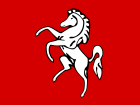Flag of Kent
 | |
| Other names | Invicta Flag, Invicta Flag of Kent |
|---|---|
| Proportion | 3:5 |
| Adopted | 1800s |
| Design | Gules, a horse rampant argent |
| Designed by | Traditional |
 | |
| Use | Variant design |
The flag of Kent is the
coats of arms and logos or symbols. It is sometimes referred to as the Invicta Flag or Invicta Flag of Kent, after the motto of Kent, Invicta.[1]
The flag is an adaptation of what was thought to be the traditional arms of Kent as popularised by Richard Verstegen's 1605 work, A Restitution of Decayed Intelligence. These arms were attributed anachronistically to the Kingdom of Kent, but used by the Justices of Kent for many years.[citation needed] The design didn't catch on as a symbol of the modern county of Kent until the mid-18th century and didn't appear in flag form until the 19th century.[2] The arms were officially granted to Kent County Council on 17 October 1933 (and re-confirmed to its successor in 1975). The flag was accepted by the Flag Institute as that of the historic county on the basis of its traditional use.[3]
See also
- List of flags of the United Kingdom
- List of English flags
- Twente
References
- ^ "Kent Invicta Flag". The Flag Institute. Retrieved 17 October 2015.
- ^ James, Lloyd (2017). The Saxon Steed and the White Horse of Kent.
- ^ "Kent Flag". British County Flags. Retrieved 17 October 2015.
It is reported that a white horse was subsequently used by the Justices of Kent for many years, being generally regarded as the emblem of the former kingdom, turned county. Kent County Council, established in 1889, was formally awarded a grant of arms, bearing the white horse, on 17 October 1933
